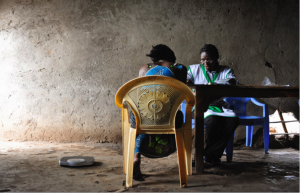Our World’s Healthy Future Needs Community Health Workers

By Katie Taylor, USAID, with Nazo Kureshy , USAID and Lesley-Anne Long mPowering Frontline Health Workers
We live in extraordinary times. In 1960, 22.2% of all children in developing countries – one out of every five – died before the age of 5. Today, we are within reach of ending preventable child deaths. Across developing countries, when compared with fifty years ago, people are living longer, more people are educated, there are fewer wars, and there is an unprecedented drop in both the number and rates of people living in extreme poverty.
At the same time, Ebola and Zika are drastic reminders of our human frailty and the need for vigilance and responsiveness – in all countries, and at all levels of care, from global down to every community, every family. The survival and safety of the women and children of the world require us to find ways to link families and communities to the knowledge, behaviors and treatments that can help them survive, thrive, and transform for the better the world they live in. 
Unlocking the potential of community health workers: a multi-pronged approach
As part of this effort, a group of 50 development practitioners, thinkers, experts, and funders came together in Wilton Park in England this week seeking to unlock the potential of community health workforces (CHW) in Africa, post-Ebola. Ministry and NGO practitioners presented models developed and being improved in Sierra Leone, Liberia, Ghana, Guinea, Rwanda, Mali, Malawi, India, Uganda, Senegal, and beyond.
Three thoughts emerge:
- Inspiring models of community health workforces already exist – which smart, experienced people are striving to make even better, through a variety of means, including policy improvements, strengthening supervision, leveraging technology, and introducing long-term domestic financing.
- There is not yet a systematic, simple way of actively sharing good practices across countries; we need to be able to compare and contrast solutions that could potentially be replicated and scaled faster, smarter, or more affordably, if we could leverage regional or global resources.
- We have not yet cracked the nut of financing. Making the Case for CHWs offered key principles and stressed the urgent need for national governments and development partners to substantially increase investment in Community Health Workers as part of integrated health care systems. We need financing solutions to be shared, adopted and adapted, as well as spur thinking on new ones.
A framework for community health
My colleagues and I shared a first version of a Community Health Framework with participants to jumpstart a “common language” on community health. This first framework highlights some laudable models and tools in a way that is simple to navigate and understand. It acts as an interactive learning tool that can help practitioners and ministries better appreciate why we should care about community health, how to approach and think about community health, and where to find successful models and examples. The framework also offers a way of looking at and acting in a common ecosystem – any country, whatever its circumstances, in order to be successful, will need to think about both help-specific and health-enabling factors, as well as ensuring resources, access, and agency.
We urge our colleagues to consider leveraging this common language in their own work, so we can begin to find commonalities and ways to better scale and replicate. We urge adopting a common language also as a way of facilitating faster, more iterative, dynamic learning within and across models. This in turn may better help us to develop financing solutions across CHW models.
What’s the role of civil society?
Just as we must think about community health workers as an integral part of the wider health system, we should also understand the critical role that civil society has to play in improving the health of populations.
Civil society engagement is recognized to be vital to achieving the Sustainable Development Goals – evidence suggests that supporting active civil society engagement promotes equity and access to improved health service delivery and health outcomes. Moreover, the new Global Strategy in support of Every Woman Every Child calls for the engagement of all sectors of society to end preventable deaths of women, children, and adolescents and ensure that all can thrive and reach their potential.
It’s a time to be bold
“The acute crisis of Ebola many be over but sustained crisis and emergency still exists” – this was the warning we heard at Wilton Park. We cannot afford not to invest in community health workforce development. Strong political will and leadership, smart investment and coordinated planning are just a few of the critical components. The private sector has much to offer – both in terms of investment and bringing strong business models for sustainable solutions.
This is the time to be bold and to be practical. Over the last three days we started to set out broad principles to achieve strong community health workforce development. As we close the conference this afternoon, I am inspired by the commitment and passion that we heard about and experienced in the room. As one of our colleagues said, “It is not easy; it requires collaboration and determination, but we know what needs to be done – now let’s go and do it”.
This post originally appears on mPowering’s website: http://mpoweringhealth.org/our-worlds-healthy-future-needs-community-health-workers/
